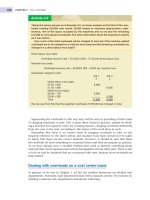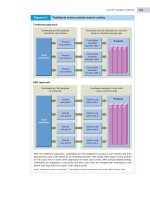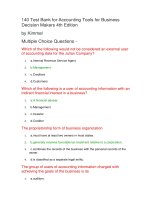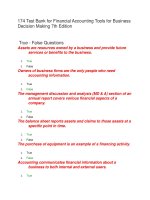Managerial economics economic tools for todays decision makers 7th edtion by keat young and erfle chapter 06
Bạn đang xem bản rút gọn của tài liệu. Xem và tải ngay bản đầy đủ của tài liệu tại đây (224.57 KB, 41 trang )
Chapter 6
The Theory and
Estimation of
Production
Chapter Outline
• The production function
• Short-run analysis of total, average and
marginal products
• Long-run production function
• Estimation of the production function
• Importance of production functions in
managerial decision making
Copyright ©2014 Pearson Education, Inc. All rights reserved.
6-2
Learning Objectives
• Define the production function
• Distinguish between the short-run and longrun production functions
• Explain the “law of diminishing returns” and
how it relates to the Three Stages of
Production
• Define the Three Stages of Production and
explain why a rational firm always tries to
operate in Stage II
Copyright ©2014 Pearson Education, Inc. All rights reserved.
6-3
Learning Objectives
• Provide examples of types of inputs that
might go into a production function
• Describe the various forms of production
functions that are used business analysis
• Briefly describe the Cobb-Douglas function
and its application
Copyright ©2014 Pearson Education, Inc. All rights reserved.
6-4
Production Function
• Production function: defines the
relationship between inputs and the
maximum amount that can be produced
within a given period of time with a given
level of technology
Q
= f(X1, X2, ..., Xk)
Q
= level of output
X1, X2, ..., Xk
= inputs used in production
Copyright ©2014 Pearson Education, Inc. All rights reserved.
6-5
Production Function
• Additional key assumptions
– A given ‘state of the art’ production technology
– Whatever input or input combinations are
included in a particular function, the output
resulting from their utilization is at the maximum
level.
– The measure of quantity is not a measure of
accumulated output, but the inputs and output
for a specific period of time.
Copyright ©2014 Pearson Education, Inc. All rights reserved.
6-6
Production Function
• For simplicity we will often consider a
production function of two inputs:
Q=f(X, Y)
Q = output
X = labor
Y = capital
Copyright ©2014 Pearson Education, Inc. All rights reserved.
6-7
Production Function
• Short-run production function: the
maximum quantity of output that can be
produced by a set of inputs
– Assumption: the amount of at least one of the
inputs used remains unchanged
• Long-run production function: the
maximum quantity of output that can be
produced by a set of inputs
– Assumption: the firm is free to vary the amount of
all the inputs being used
Copyright ©2014 Pearson Education, Inc. All rights reserved.
6-8
Short-run Analysis of Total,
Average, and Marginal Product
• Alternative terms in reference to inputs
–
–
–
–
‘inputs’
‘factors’
‘factors of production’
‘resources’
• Alternative terms in reference to outputs
–
–
–
–
‘output’
‘quantity’ (Q)
‘total product’ (TP)
‘product’
Copyright ©2014 Pearson Education, Inc. All rights reserved.
6-9
Short-run Analysis of Total,
Average, and Marginal Product
• Marginal product (MP) = change in output
(Total Product) resulting from a unit change
in a variable input
Q
MPX
X
• Average product (AP) = Total Product per
unit of input used
Q
APX
X
Copyright ©2014 Pearson Education, Inc. All rights reserved.
6-10
Short-run Analysis of Total,
Average, and Marginal Product
• if MP > AP then AP is rising
• if MP < AP then AP is
falling
• MP=AP when AP is
maximized
Copyright ©2014 Pearson Education, Inc. All rights reserved.
6-11
Short-run Analysis of Total,
Average, and Marginal Product
• Law of diminishing returns: as additional
units of a variable input are combined with a
fixed input, after some point the additional
output (i.e., marginal product) starts to
diminish
– nothing says when diminishing returns will start
to take effect
– all inputs added to the production process have
the same productivity
Copyright ©2014 Pearson Education, Inc. All rights reserved.
6-12
Short-run Analysis of Total,
Average, and Marginal Product
• The Three Stages of Production in the
short run:
– Stage I: from zero units of the variable input to
where AP is maximized (where MP=AP)
– Stage II: from the maximum AP to where MP=0
– Stage III: from where MP=0 on
Copyright ©2014 Pearson Education, Inc. All rights reserved.
6-13
Short-run
Analysis of Total,
Average, and
Marginal Product
Copyright ©2014 Pearson Education, Inc. All rights reserved.
6-14
Short-run Analysis of Total,
Average, and Marginal Product
• In the short run, rational firms should be
operating only in Stage II
Q: Why not Stage III? firm uses more variable
inputs to produce less output
Q: Why not Stage I? underutilizing fixed
capacity, so can increase output per unit by
increasing the amount of the variable input
Copyright ©2014 Pearson Education, Inc. All rights reserved.
6-15
Short-run Analysis of Total,
Average, and Marginal Product
• What level of input usage within Stage II is
best for the firm?
The answer depends upon:
–
–
–
–
how many units of output the firm can sell
the price of the product
the monetary costs of employing
the variable input
Copyright ©2014 Pearson Education, Inc. All rights reserved.
6-16
Short-run Analysis of Total,
Average, and Marginal Product
• Total revenue product (TRP) = market
value of the firm’s output, computed by
multiplying the total product by the market
price
TRP = Q · P
Copyright ©2014 Pearson Education, Inc. All rights reserved.
6-17
Short-run Analysis of Total,
Average, and Marginal Product
• Marginal revenue product (MRP) =
change in the firm’s TRP resulting from a
unit change in the number of inputs used
MRP =
MP · P
Copyright ©2014 Pearson Education, Inc. All rights reserved.
=
TRP
X
6-18
Short-run Analysis of Total,
Average, and Marginal Product
• Total labor cost (TLC) = total cost of using the
variable input labor, computed by multiplying the
wage rate by the number of variable inputs
employed
TLC = w · X
• Marginal labor cost (MLC) = change in total labor
cost resulting from a unit change in the number of
variable inputs used
MLC = w
Copyright ©2014 Pearson Education, Inc. All rights reserved.
6-19
Short-run Analysis of Total,
Average, and Marginal product
• Summary of relationship between demand
for output and demand for a single input:
A profit-maximizing firm operating in perfectly
competitive output and input markets will be
using the optimal amount of an input at the point
at which the monetary value of the input’s
marginal product is equal to the additional cost of
using that input
MRP = MLC
Copyright ©2014 Pearson Education, Inc. All rights reserved.
6-20
Short-run Analysis of Total,
Average, and Marginal Product
• Multiple variable inputs
– Consider the relationship between the ratio of the
marginal product of one input and its cost to the
ratio of the marginal product of the other input(s)
and their cost
MP1 MP2 MPk
w1
w2
wk
Copyright ©2014 Pearson Education, Inc. All rights reserved.
6-21
Short-run Analysis of Total,
Average, and Marginal Product
Copyright ©2014 Pearson Education, Inc. All rights reserved.
6-22
Long-run Production Function
• In the long run, a firm has enough time to
change the amount of all its inputs
• The long run production process is described
by the concept of returns to scale
• Returns to scale = the resulting increase
in total output as all inputs increase
Copyright ©2014 Pearson Education, Inc. All rights reserved.
6-23
Long-run Production Function
• If all inputs into the production process are
doubled, three things can happen:
– output can more than double
• ‘increasing returns to scale’ (IRTS)
– output can exactly double
• ‘constant returns to scale’ (CRTS)
– output can less than double
• ‘decreasing returns to scale’ (DRTS)
Copyright ©2014 Pearson Education, Inc. All rights reserved.
6-24
Long-run production function
• One way to measure returns to scale is to
use a coefficient of output elasticity:
Percentage change in Q
EQ
Percentage change in all inputs
if EQ > 1 then IRTS
if EQ = 1 then CRTS
if EQ < 1 then DRTS
Copyright ©2014 Pearson Education, Inc. All rights reserved.
6-25









